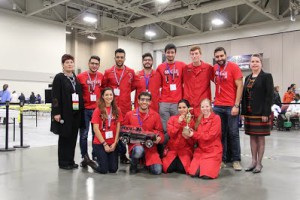Cornell University and McGill University tied for first place in the 17th Annual Chem-E-Car competition. The collegiate event features cars ranging in size from shoeboxes to fire hydrants powered by alternative fuels. The competition is sponsored by the American Institute of Chemical Engineers (AIChE) and its goal is to teach chemical engineering students to think creatively about alternative fuels. Cornell’s winning car Drifter was powered by a zinc alkaline battery, while McGill’s Navona Car was powered by a lead flow battery.
“The Chem-E-Car competition is a great avenue for students to apply chemical engineering principles in a creative way and in a group setting, they are critically important skills for these young professionals to have as they begin their journeys in the industry,” said Cheryl Teich, AIChE President.
For the competition, the teams create a car using a variety of materials and fueling methods, showcasing their innovation and creativity. For the first time ever, three teams used 3D printing to make parts of their cars while other teams used beef liver and hydrogen peroxide, Vitamin C, and dyes to produce a chemical reaction to power their car.
An hour before the competition, the students are told the load of water their car must carry and the distance it must travel. The students then must calculate the appropriate chemical reaction that will propel the car as close as possible to the distance goal. This year, the cars had to carry 230 milliliters of water for 20.3 meters, and the winning teams were 5 centimeters from the finish line, both taking $2,000 first place prizes.
McGill has only participated in Chem-E-Car for the past two years and is now national champions. This is Cornell’s fourth national championship, having won Chem-E-Car in 2008, 2010, and 2012. The third place award went to the University of California, Davis. Their vehicle, Leadfoot, was powered by a lead acid battery. Chem-E-Car Competition prizes are sponsored by Chevron.



